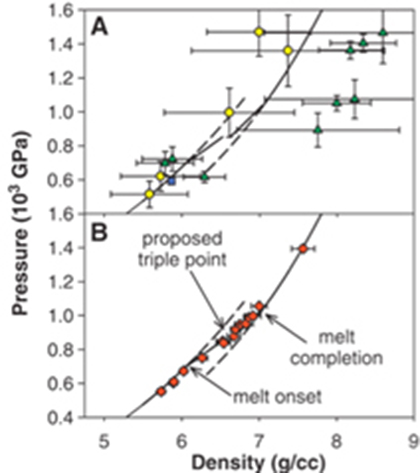Diamonds are not forever
Carbon can be found in two different structures under normal conditions: graphite and diamond. Although both are made up of carbon atoms, the two different atomic structures result in vastly different properties of the materials: graphite is black and soft, diamond is transparent and hard, in fact one of the hardest materials known.
When faced with the challenge of designing a fusion capsule of diamond for the National Ignition Campaign (NIC) or deciphering the structure of a giant planet like Neptune, it is vital to know the behavior of carbon under conditions where the pressure is 10 million atmospheres (1000 GPa) and the temperature is several thousand degrees.
Advanced quantum chemistry simulations such as those described in BSCs x and y can predict which structures should exist. For carbon, it turns out that the BC8 structure is favored over diamond at high pressure. BC8 is a tetragonal arrangement that packs atoms more efficiently than the diamond structure. In addition, the simulations showed that when subjecting diamond to shocks of increasing strength, the diamond begins melting at 7900 K and 680 GPa and completes melting in a complicated way. A nearly 400 GPa solid-liquid coexistence region, starting around 680 GPa, and completing around 1040 GPa encompasses a diamond-liquid-BC8 triple point at 850 GPa. Needless to say, such a complex behavior has profound implications for the behavior and design of a fusion capsule.
When the outcome of a fusion experiment lies in the balance, it is imperative to validate theoretical equations of state with high accuracy experiments. The second figure shows how well these simulations predicted the complex shock melting of diamond (Knudson et. al. 2008).
Such integration of experiments and theory with high fidelity is the basis for understanding chemistry and physics under extreme conditions.

Phase diagram of carbon (gray solid lines are phase boundaries) showing the triple point of diamond, bc8, and liquid. The shock trajectory (Hugoniot) is the full black line (Knudson et al 2008).

Shock pressure of diamond (Knudson et al 2008). Black full line is prediction from DFT/AIMD. Symbols are data using laser drivers (A) and magnetic flyer drive (B).
Excerpted from Scientific Grand Challenges for National Security: The Role of Computing at the Extreme Scale, October 6-8, 2009, Washington D.C., Pg. 77 (PDF, 11.4 KB)